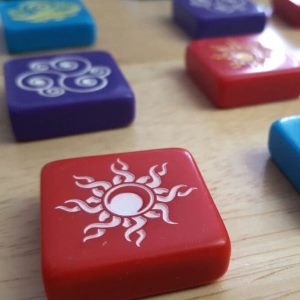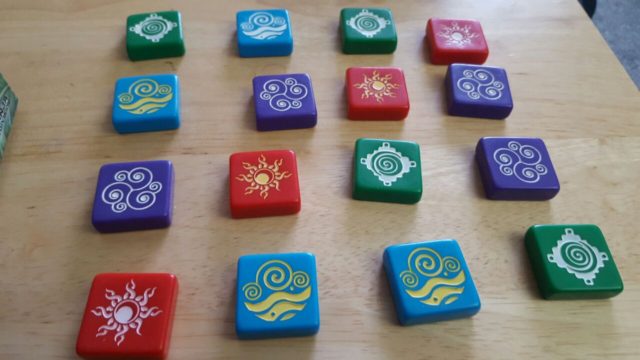
Those of you who read our reviews regularly might think that a game whereby you turn tiles over to make specific patterns sounds strangely familiar. Well, you’d be right – you only need to cast an eye back to our review of the very enjoyable Clacks to realise that Codinca shares many of the gameplay mechanics with its Discworld-themed cousin, and carries the same objectives of trying to manipulate the tiles into certain patterns in order to complete a set of given patterns. And yet as a result of a lighter set of rules and ingenious portability, Codinca feels quite different and has its own place on your shelf alongside Clacks.
The first thing to note is that Codinca doesn’t have a board. Instead, you just have the 16 tiles required to play the game, and a set of round cards which you’ll be using throughout. This immediately gives the game the benefit of being able to be played pretty much anywhere that you’ve got a roughly A4-sized space to position the pieces. With the game coming in a satisfyingly small box as well this makes it great to chuck in your pocket on your way to someone’s house, for a train journey or a cheeky game in your lunch break at work, also helped by the fact that the rules are so easy to learn you can teach someone and play a couple of games before even needing to keep an eye on the clock. Handy.
The idea of the game is to manipulate the starting pattern of tiles by moving or turning them, and in doing so matching the set patterns you have on the cards handed out at the start. The simplified rules manifest themselves as the very small number of actions you can do on your turn, such as swapping one of your tiles (denoted by the colour and image on the tiles) with one next to it, or flipping one over to turn it from white to yellow (or stone to gold in game-speak). You can also use one of your cards to push a line or column along one space which sends the tile pushed off the grid over to the other side, or you can rotate a group of four tiles – doing either of these things though means you lose that card, so it’s a good idea to be mindful when doing so. But that’s pretty much it in terms of your move set. As such Codinca is very very easy to learn how to play, and is far easier than Clacks in terms of actually forming the patterns needed and getting through the game.

But the unexpected issue here is whether the game is too easy, and therefore nudging towards frustrating when trying to be tactical. The question comes about as a result of each player keeping their target patterns secret throughout the game, unlike Clacks where each player’s intended words are laid out in front of them. As such you’re really just playing for yourself; there’s no way you can sabotage the other players be intentionally blocking their efforts, or choose the order of your own goals just to be less helpful to the others around the table. You’re basically just waiting for your turn to come around, then working out if there’s anything you can do in order to finish off one of your cards. As such, we found it worked slightly better as a two player game with less waiting for your turn, but playing with fewer players does potentially make it even easier to succeed, and therefore shortens the game quite a bit.
This is, however, only a problem if you were hoping Codinca was going to be a deeply tactical experience, and I’m not convinced that was ever really the point. Where Codinca shines is in the situations I mentioned earlier, where you might want a quick blast in your lunch break, or a fun way to start or end a night of gaming without having to really get too engrossed in anything too complex. It’s not meant to have the same depth as Clacks, or the same multiplayer competitiveness of some of the other games in your collection, but is still an excellent and accessible game if you’re looking for something light, portable and easy to play.
Codinca
Available Now, RRP £14.99
Find your local stockist here

Leave a Reply